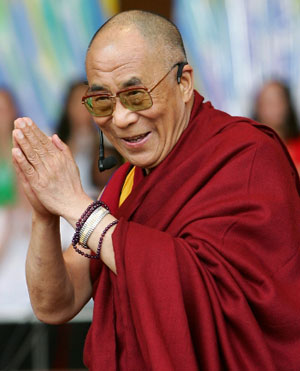|
Lhamo Thondup was born in a peasant family on July 6,
1935 in the small village of Taktser in the
north-eastern Tibetan province of Amdo. At the age of
two, he was recognized as the reincarnation of the 13th
Dalai Lama. As such, Tibetans consider Tenzin Gyatso,
the 14th Dalai Lama, to be a living Buddha, a
manifestation of the Buddha. He was throne on February
22, 1940 at Lhasa. At the age of six, he began his
monastic education in the Tibetan capital of Lhasa. In
early March 1959, in front of 20,000 scholars, the Dalai
Lama passed his final examination to qualify as a Geshe.
At the age of 15 he was asked by the Tibetan Government
to take the full responsibility as Head of the state and
raise voice against the Chinese invasion of Tibet. An
appeal to united Nations was made.
On March 10, 1959, Chinese military invited |
 |
|
|
the Dalai Lama to attend, without bodyguards, a theatrical
performance to be held inside their compound. Rumours spread
throughout Lhasa that the Dalai Lama would be kidnapped by the
Chinese military. By the morning of 10 March, huge crowds of
Tibetans had gathered outside the Norbulingka, the Dalai
Lama's Summer Palace, with the intention of protecting him.
This was the beginning of the Tibetan Uprising against the
Chinese in Tibet. During the Uprising, which lasted for nearly
two weeks, it has been estimated that more than 87,000
Tibetans died. The Dalai Lama and his immediate family escaped
in disguise from Lhasa on the evening of 17 March, 1959. He
crossed the border into India on 30 March, where he was
granted asylum. Approximately 80,000 Tibetans followed the
Dalai Lama across the Himalayas into exile.
The Indian Government offered the Dalai Lama a home in
Dharamshala, a small town in the foothills of the Himalayas in
the state of Himachal Pradesh. From here, the Tibetan
Government-in-Exile drafted a constitution for an autonomous
and democratic Tibet and holds elections for the Tibetan
Parliament.
The Dalai Lama did not travel outside India until 1967, when
he visited Japan and Thailand. Since then, he has visited more
than 45 countries, giving Buddhist teachings and talks on a
wide variety of spiritual and ethical topics and urging world
leaders to assist him in bringing about a resolution to the
Tibetan situation. In 1988, the Dalai Lama put forward the
'Strasbourg Proposal' to the European Parliament in which he
called for genuine autonomy for Tibet rather independence,
thus making a major compromise. In 1989, the Dalai Lama was
awarded the Nobel Peace Prize for his peaceful struggle for
the liberation of Tibet. |